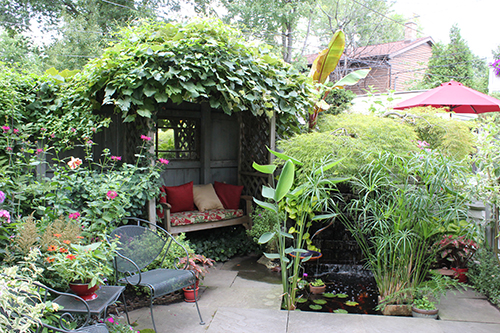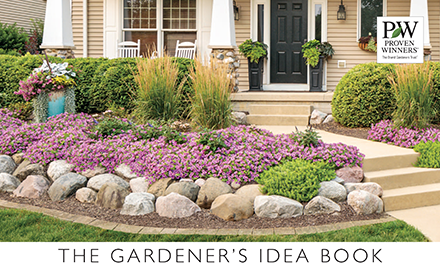Grow Up – Vertical Gardening
You should really grow up! Wait, let me put that a better way…you should really try vertical gardening. While it has become kind of a trendy concept in recent years, vertical gardening is about way more than those fashionable green walls you see everywhere. At its simplest, vertical gardening means that you’re using every available inch to create a special outdoor space where you can be surrounded by greenery, and it especially makes sense if you have limited space. Whether you have a balcony, patio, or small yard, or are just looking to make a retreat worthy of Instagram and Pinterest, these basic vertical gardening principles will help you get the most from your garden while minimizing effort and expense.

Use plants with a small footprint
 As is the case with so many things in gardening, success starts with choosing the right plants. And if you need big impact in a small space, turn to plants that have a small footprint but provide lots of drama – in other words, plants that naturally grow with a narrow, column-like shape. Botanically, this is known as having a fastigiate (fah-stidge-itt) habit.
As is the case with so many things in gardening, success starts with choosing the right plants. And if you need big impact in a small space, turn to plants that have a small footprint but provide lots of drama – in other words, plants that naturally grow with a narrow, column-like shape. Botanically, this is known as having a fastigiate (fah-stidge-itt) habit.
Fortunately, all sorts of plants are fastigiate and fabulous! These varieties take up just a foot or so of ground space but they have lots of WOW wherever you plant them:
Shrubs
• Purple Pillar® Hibiscus
• White Pillar™ Hibiscus
• Patti O Box™ Japanese Holly Ilex
• Sky Box™ Japanese Holly Ilex
• Fine Line® Rhamnus
• Laced Up™ Elderberry Sambucus
• North Pole® Arborvitae Thuja
While this habit does tend to be seen more in woody plants, there are some great annuals like the Tut series of Graceful Grasses that will make an outsized statement for the amount of real estate they require.
Vines
 Vines are the ultimate tool for vertical gardeners – they naturally cover walls, trees, and other structures to create that gorgeous “green curtain” look. Vines climb by different methods, and you must match the structure you want to cover with the way the vine grows. Red Wall® Virginia creeper for example, climbs walls or trees with tiny little suction-cup like structures, needing little help from gardeners. It’s shade tolerant so very well suited to shady urban spaces, and it’s virtually care-free. Climbing hydrangea and false hydrangea vine like Rose Sensation™ grow similarly, but put out spidery rootlets instead of suction cups. A vining honeysuckle like ‘Scentsation’ grows by wrapping its woody stems around posts or tree trunks –it can’t climb a wall. That’s also the case for twining A-Peel® black-eyed Susan vines. Either of these are a perfect choice for covering posts, railings, or training up strings. The annual A-Peel vines are an especially nice option for covering a structure seasonally or while you are waiting for a woody vine to get established.
Vines are the ultimate tool for vertical gardeners – they naturally cover walls, trees, and other structures to create that gorgeous “green curtain” look. Vines climb by different methods, and you must match the structure you want to cover with the way the vine grows. Red Wall® Virginia creeper for example, climbs walls or trees with tiny little suction-cup like structures, needing little help from gardeners. It’s shade tolerant so very well suited to shady urban spaces, and it’s virtually care-free. Climbing hydrangea and false hydrangea vine like Rose Sensation™ grow similarly, but put out spidery rootlets instead of suction cups. A vining honeysuckle like ‘Scentsation’ grows by wrapping its woody stems around posts or tree trunks –it can’t climb a wall. That’s also the case for twining A-Peel® black-eyed Susan vines. Either of these are a perfect choice for covering posts, railings, or training up strings. The annual A-Peel vines are an especially nice option for covering a structure seasonally or while you are waiting for a woody vine to get established.
Clematis vines are also a good choice for vertical interest, but the way they climb is rather different – they wrap their leaf stems around whatever they are trying to climb. As such, they require a finer support than twining vines do - a chain link fence or latticed structure works well. Another fun use for clematis in vertical gardening is to plant it at the base of an evergreen hedge and let it ramble through the plant. It won’t hurt it, but it will pepper it with colorful flowers where you least expect it. Talk about getting the most from your space!
Tree form shrubs
 Tree-form shrubs, also known as standards, take what would normally be a large, voluminous plant and turn it into a small, streamlined plant with a distinctive profile and minimal footprint. They look a bit like a lollipop, which means the good stuff – the flowers and foliage – will be right at eye level, exactly what you want in a vertical garden. You’ll find tree-form versions of many popular flowering shrubs:
Tree-form shrubs, also known as standards, take what would normally be a large, voluminous plant and turn it into a small, streamlined plant with a distinctive profile and minimal footprint. They look a bit like a lollipop, which means the good stuff – the flowers and foliage – will be right at eye level, exactly what you want in a vertical garden. You’ll find tree-form versions of many popular flowering shrubs:
• Panicle hydrangea
• Ninebark
• Lilac
• Weigela
• Rose of Sharon
Because of the extra time and work required to train these plants into the tree form, they typically cost more than the shrub version. However, for lots of beauty from a small space, they’re hard to beat, and they may be the only way those with limited space can enjoy them. You can learn more about caring for tree form shrubs in our article.
Windowboxes and baskets
 One of the simplest ways to create that “green wall” effect that is so associated with vertical gardening is to use windowboxes and hanging baskets. Well-placed windowboxes and hanging baskets can make the difference between a pretty space and an extraordinary one. The more, the merrier! Don’t limit windowboxes to just under windows – fasten them to walls to add color anywhere and everywhere. Same with hanging baskets – if you can find a place to put a hook or bracket, you can add a spot of luscious color. For vertical gardening, the most effective windowboxes are going to incorporate lots of “spillers” – plants that cascade downward like Supertunia® and Superbells® combined with plants that grow upward to create a full look. Need inspiration for windowboxes or hanging baskets? Check out our recipes!
One of the simplest ways to create that “green wall” effect that is so associated with vertical gardening is to use windowboxes and hanging baskets. Well-placed windowboxes and hanging baskets can make the difference between a pretty space and an extraordinary one. The more, the merrier! Don’t limit windowboxes to just under windows – fasten them to walls to add color anywhere and everywhere. Same with hanging baskets – if you can find a place to put a hook or bracket, you can add a spot of luscious color. For vertical gardening, the most effective windowboxes are going to incorporate lots of “spillers” – plants that cascade downward like Supertunia® and Superbells® combined with plants that grow upward to create a full look. Need inspiration for windowboxes or hanging baskets? Check out our recipes!
Turn hard spaces into green spaces with containers

Containers not only allow you to put a little garden anywhere, even on hard surfaces, they also are the perfect opportunity to express your personal style! Though nice containers are often expensive, you’ll never regret investing in a few containers that you absolutely love. For the most vertical gardening impact, look for containers that are taller than they are wide so that once again, you’re minimizing the footprint while putting the showiest parts of the plant at eye level or higher. For maximum versatility, concentrate your collection on those that are 14” diameter or larger. These bigger sizes allow you to plant anything from a showy flowering shrub to a lush tropical plant or hosta to an exuberant planting of annuals. Plus, you can move containers around to keep your space interesting and dynamic or to create more privacy.
Like all gardens, the best vertical gardens develop when you dare to imagine what’s possible and express yourself and your personal style at every opportunity. Remember, the only person you need to please is you. Dream big and have fun!




